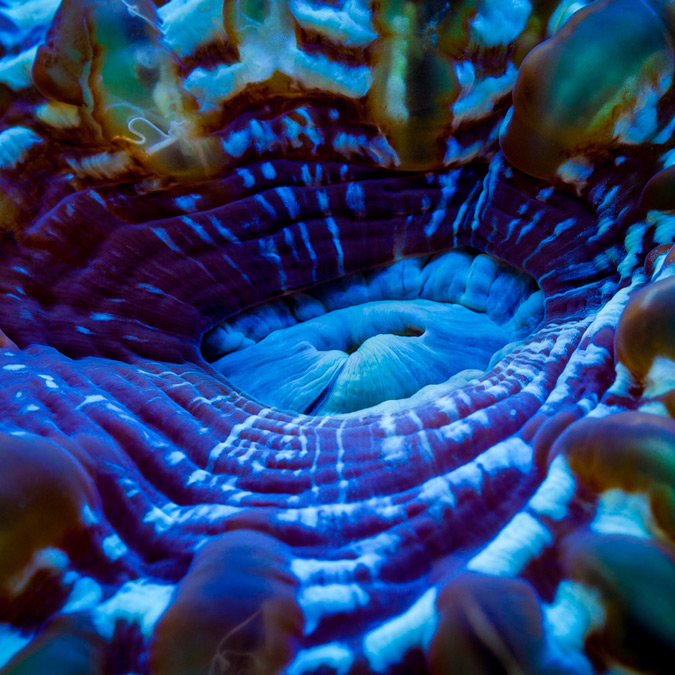Cynarina are commonly referred to as meat corals or cat’s eye corals. They are large-polyp stony (LPS) corals that grow as a single massive polyp. In many ways, Cynarina share similar traits to Scolymia, Acanthophyllia, and bubble corals of the genus Plerogyra. They are very similar to Plerogyra in particular given that they both have translucent bubbles that make up the outer rim of the polyp.
Chromatic diversity
Unlike Plerogyra, which come in limited color variants, Cynarina have amazing chromatic diversity. The shape of their bubbles can vary to some degree; however, their color is really where their diversity shines. Cynarina can come in a wide variety of colors and even have secondary colors seemingly embedded within the bubbles. It’s almost like they have bursts of color trapped in amber.
In addition to their color, their translucence allows for some interesting hobbyist-made optical tricks. They have a stony base that can be safely placed on a small section of PVC pipe. From a top-down vantage point, the white PVC makes it look as though there is a white, halo-like ring on the face of the coral.
Theoretically, you could get even more creative and place the coral on a small section of fluorescent acrylic tube, which comes in a variety of colors and glows brightly under actinic lights. It would not be a particularly natural look, but if you have ever been diving, you know that just about everything we do in this hobby is pretty unnatural. This trick would produce a very surreal effect.
Care requirements
As for care, Cynarina are fairly hardy corals, which may come as a surprise given their delicate appearance. They can thrive in a variety of tank conditions. In terms of light, we recommend medium light levels. Their color remains very consistent across a range of intensities and color spectrums. You’re more likely to damage a coral like this with too much light as opposed to too little, so we recommend no more than medium light at first.
As for circulation, low to medium flow works best. Cynarina are particularly fleshy, and you want to avoid hitting them with extremely strong flow, which could either collapse their body or, worse, blow them upside down. When fully extended, the body could act as a parachute and lift off, so strong flow is a no-no.
Like many LPS corals, Cynarina are easily fed and seem to benefit greatly from regular feeding. We have fed Cynarina both frozen foods as well as pellets. They are not finicky eaters in the slightest. However, one thing I’ve noticed is that they have almost no tentacle extension. They seem to use a mucus web like a chalice coral.
Propagation
The downside for me is that these corals cannot be propagated. It may be possible to cut them and have the pieces survive, but the shape would be all wrong. This coral does not seem to be a type that would regain its shape any time soon. It will be interesting to see if this hobby ever progresses to the point that sexual reproduction of these corals is possible.
Conclusion
Cynarina make great additions to mixed reef tanks for beginner and advanced aquarists alike. They are fairly uncommon and provide an eye-catching focal point.



